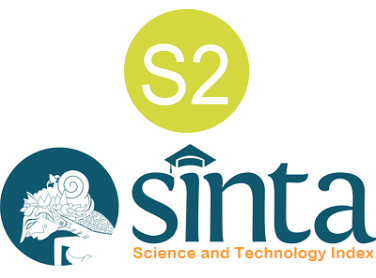Poliandri Sebuah Refleksi Ajaran Bhakti dan Śraddhā dalam Kakawin Kreṣṇā Pancawiwāha
DOI:
https://doi.org/10.37329/jpah.v9i1.3752Keywords:
Poliandri, Kakawin, Bhakti dan Sradha, Kajian SemiotikaAbstract
Kakawin Kreṣṇā Pancawiwāha tells the story of Dewi Kresna's marriage to Panca Pandawa, which is interesting to study because the concept of marriage in this text has shifted. The marriage that is supposed to be between a man and a woman is told differently in this text, where a woman marries five men at the same time, known as polyandry. The polyandrous marriage narrated in the Kakawin Kreṣṇā Pancawiwāha text is actually not merely the main purpose, but a symbolic one that has meaning in it. The purpose of this paper is to reveal the symbolic meanings of polyandry that have relevance to Hindu religious teachings. This research is an analytical descriptive research with a textual approach that uses the text of Kakawin Kreṣṇā Pancawiwāha as the main data source. The method used in the data collection stage is literature study with translation, listening, and note-taking techniques. In the analysis stage, the analytical descriptive method was used, assisted by interpretative techniques based on the working principles of semiotic theory. The result found is that the phenomenon of polyandry in the Kakawin Kreṣṇā Pancawiwāha text is a symbol that contains religious philosophical values for Hindus to reflect the teachings of Bhakti (devotion) and Śraddhā (belief). The implementation of the teachings of Bhakti (devotion) is realized by the attitude of Satya Laksana (loyal to the righteous actions) to Guru Rupaka (parents) as a reflection of the teachings of Guru Bhakti. Symbolic polyandry as a concept of Śraddhā, is realized by the reflection of the teachings of Karmaphala Sraddha (belief in the existence of karma) which has a reciprocal relationship with Punarbhawa Sraddha (belief in the existence of repeated births). The mythology found states that polyandry is an existence of life that has implications for the improvement of Bhakti and Śraddhā.
References
Agustina, M. (2017). Faktor-Faktor terjadinya Poliandri di Masyarakat (Studi Kasus di Kabupaten Pidie Jaya). Samarah: Jurnal Hukum Keluarga dan Hukum Islam, 1(1), 2549–3167.
Aziz, A. N. (2023). Poliandri Drupadi dalam Perspektif Psikologi Islam. Jurnal Al-Qalb Psikologi Islam, 14(1), 16–30.
Creese, H. (2015). The Women of The Kakawin World Marriage and Sexuality in the Indic Courts of Java and Bali. London and New York: Routledge.
Dauh, I. W. (2019). Ajaran Karmaphala dan Panca Satya dalam Geguritan Jayaprana. Jurnal Vidya Wertta, 2(1), 52–65.
Donder, I. K. (2006). Sisya Sista. Surabaya: Paramita.
Gata, W. (2024). Perkawinan Nyuang Luh Ring Dura Desa Di Desa Pakraman Sembiran Kecamatan Tejakula Kabupaten Buleleng Kajian Sosio-Religius. Jayapangus Press Jurnal Penelitian Agama Hindu, 8(1), 118–129.
Gunadha, I. B. (2013). Panca Śraddhā Lima Prinsip Keimanan Hindu Indonesia. Denpasar: Widya Dharma.
Hariyanto, D. (2022). Pentingnya Ajaran Panca Śraddhā Untuk Membentuk Militansi Agama Generasi Hindu. Swara Vidya, 11(1), 1–10.
Kemenuh, A. (2020). Ajaran Karma Phala Sebagai Hukum Sebab Akibat Dalam Hindu. Pariksa, 4(1), 22–29.
Mantra, I. B., Sugriwa, I. G. B., Sarkar, H. B., Kern, J. H. C., & Rassers, W. H. (2002). Ciwa-Buddha Puja di Indonesia. Denpasar: Yayasan Dharma Sastra.
Martha, W. (2018). Posisi Wanita Pada Hukum Hindu Dalam Sistem Vivaha Samskara. Vidya Wertta, 1(2), 7–14.
Natih, P. A. (2021). Panca Satya Tersirat dalam Epos Mahabharata Sebagai Pendidikan Karakter Generasi Hindu. Guna Widya: Jurnal Pendidikan Hindu Jurusan Pendidikan Agama, 8(2), 180–189.
Puniatmaja, I. B. O. (1970). Cilakrama. Jakarta: Departemen Agama RI.
Sari, N. L. R., & Suwantana, I. G. (2023). Guru Bhakti Dalam Taittriya Upanisad. Veda Jyotih Jurnal Agama dan Sains, 2(1), 17–29.
Suadnyana, I. B. P. E. (2018). Nilai Yang Terkandung Dalam Geguritan Mituturin Angga. Jurnal Sanjiwani, 9(2), 47–60.
Suhardana, K. (2010). Karmaphala Menciptakan Karma Baik Menurut Kitab Suci Hindu. Surabaya: Paramita.
Suhardana, K. (2011). Punarbhawa Reinkarnasi, Samsara atau Penitisan. Surabaya: Paramita.
Suhardana, K. (2021). Panca Sraddha. Surabaya: Paramita.
Suharko dkk, I. N. (2021). Eksistensi Kepongor Di Bali Refleksi Terhadap Ajaran Karmaphala. Jurnal Pangkaja, 24(1), 40–51.
Titib, I. M. (1996). Perkawinan dan Kehidupan Keluarga Menurut Kitab Suci Veda. Surabaya: Paramitha.
Wahyuni, T. S. (2021). Analisis Wacana Kritis Pada Komunitas Indonesia Tanpa Poligami (ITAMI) di Instagram. JIEE: Jurnal Ilmiah Ekotrans & Erudisi, 1(2).
Widiantara, I. K. (2019). Esensi Kehidupan Manusia dalam Teks Geguritan Aji Sesana. Kalangwan Jurnal Pendidikan Agama, Bahasa dan Sastra, 9(2), 114–121.
Widiastuti, I. A. N., & Raimahayanti, N. M. (2023). Śraddhā dan Bhakti Dalam Mencegah Penyalahgunaan Media Sosial. Metta: Jurnal Ilmu Multidisiplin, 3(4), 546–560.
Zoetmulder, P. J. (1985). Kamus Jawa Kuna-Indonesia. Jakarta: PT Gramedia Pustaka Utama.
Downloads
Published
How to Cite
Issue
Section
License
Copyright (c) 2025 Ni Made Wikandina Putri, I Ketut Sudewa, I Nyoman Udayana

This work is licensed under a Creative Commons Attribution-ShareAlike 4.0 International License.
An author who publishes in the Jurnal Penelitian Agama Hindu agrees to the following terms:
- Author retains the copyright and grants the journal the right of first publication of the work simultaneously licensed under the Creative Commons Attribution-ShareAlike 4.0 License that allows others to share the work with an acknowledgement of the work's authorship and initial publication in this journal
- Author is able to enter into separate, additional contractual arrangements for the non-exclusive distribution of the journal's published version of the work (e.g., post it to an institutional repository or publish it in a book) with the acknowledgement of its initial publication in this journal.
- Author is permitted and encouraged to post his/her work online (e.g., in institutional repositories or on their website) prior to and during the submission process, as it can lead to productive exchanges, as well as earlier and greater citation of the published work (See The Effect of Open Access).
Read more about the Creative Commons Attribution-ShareAlike 4.0 Licence here: https://creativecommons.org/licenses/by-sa/4.0/.








